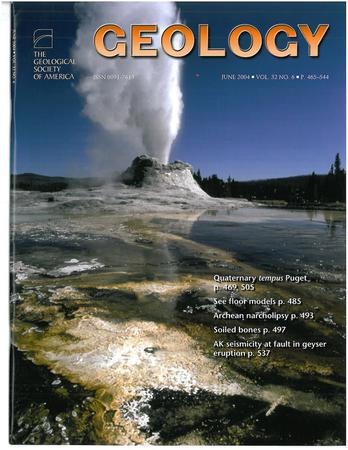第勒尼安海马西里盆地50000年的反复火山碎屑巨床沉积
IF 4.8
1区 地球科学
Q1 GEOLOGY
引用次数: 0
摘要
巨型沉积物是特别大的海底沉积物,被解释为起源于单一的灾难性事件。巨型钻柱是深水盆地的重要组成部分,对了解地质灾害至关重要。我们在第勒尼安海西部Marsili盆地的上部70米处发现了4个兆层的连续沉积,沉积在过去的50公里内。兆层被成像为独特的声学透明单元,具有池状几何形状,厚10 - 25米,由平行层状地层隔开。海洋钻探项目Leg 107 Site 650的岩心显示,四个兆柱中有三个是由火山碎屑砂和泥浆交替形成的,一个是火山碎屑流。巨型海床中丰富的浅水底栖有孔虫表明它们不是来自活跃的马西里海山,而很可能来自北部的坎帕尼亚火山省。巨岩沉积的时间间隔包括39.8 ka坎帕尼亚坎皮弗莱格雷火山口的火成岩超级喷发,这是地球上已知的最大喷发之一,以及14.9 ka那不勒斯黄凝灰岩超级喷发。体积(最小)估计范围为1.3至13.3立方公里。然而,在邻近的西部Vavilov盆地中观测到的类似的兆流表明,两个盆地的兆流可能是相关的,因此体积可能要大得多。新发现的马西里盆地巨型板块揭示了环第勒尼安海岸线的重大地质灾害事件,其复发间隔约为~ 10 ~ 15 ky。本文章由计算机程序翻译,如有差异,请以英文原文为准。
50,000 yr of recurrent volcaniclastic megabed deposition in the Marsili Basin, Tyrrhenian Sea
Megabeds are exceptionally large submarine deposits interpreted to originate from single catastrophic events. Megabeds are significant components of deep-water basins and are critical for understanding geohazards. We discovered a succession of four megabeds within the upper 70 m of the western Marsili Basin, Tyrrhenian Sea, deposited within the past 50 k.y. The megabeds were imaged as distinctive acoustically transparent units with ponded geometries, 10−25 m thick, separated by parallel-bedded strata. Cores from Site 650 of Ocean Drilling Program Leg 107 revealed that three of the four megabeds are made of alternating volcaniclastic sand and mud, and one is a volcaniclastic debris flow. Abundant shallow-water benthic foraminifera within the megabeds suggest that they were not sourced locally from the active Marsili Seamount, but most likely originated from the Campanian volcanic province to the north. The time interval during which the megabeds were deposited includes the 39.8 ka Campanian ignimbrite supereruption of the Campi Flegrei caldera, Italy, which is among the largest known eruptions on Earth, and the 14.9 ka Neapolitan Yellow Tuff supereruption. Volume (minimum) estimates range from 1.3 to 13.3 km3. However, similar megabeds observed in the neighboring Vavilov Basin to the west suggest that the megabeds in both basins may be correlative, and thus volumes could be much larger. The newly discovered megabeds of the Marsili Basin reveal significant geohazard events for the circum−Tyrrhenian Sea coastlines with a recurrence interval on the order of ∼10−15 k.y.
求助全文
通过发布文献求助,成功后即可免费获取论文全文。
去求助
来源期刊

Geology
地学-地质学
CiteScore
10.00
自引率
3.40%
发文量
228
审稿时长
6.2 months
期刊介绍:
Published since 1973, Geology features rapid publication of about 23 refereed short (four-page) papers each month. Articles cover all earth-science disciplines and include new investigations and provocative topics. Professional geologists and university-level students in the earth sciences use this widely read journal to keep up with scientific research trends. The online forum section facilitates author-reader dialog. Includes color and occasional large-format illustrations on oversized loose inserts.
 求助内容:
求助内容: 应助结果提醒方式:
应助结果提醒方式:


